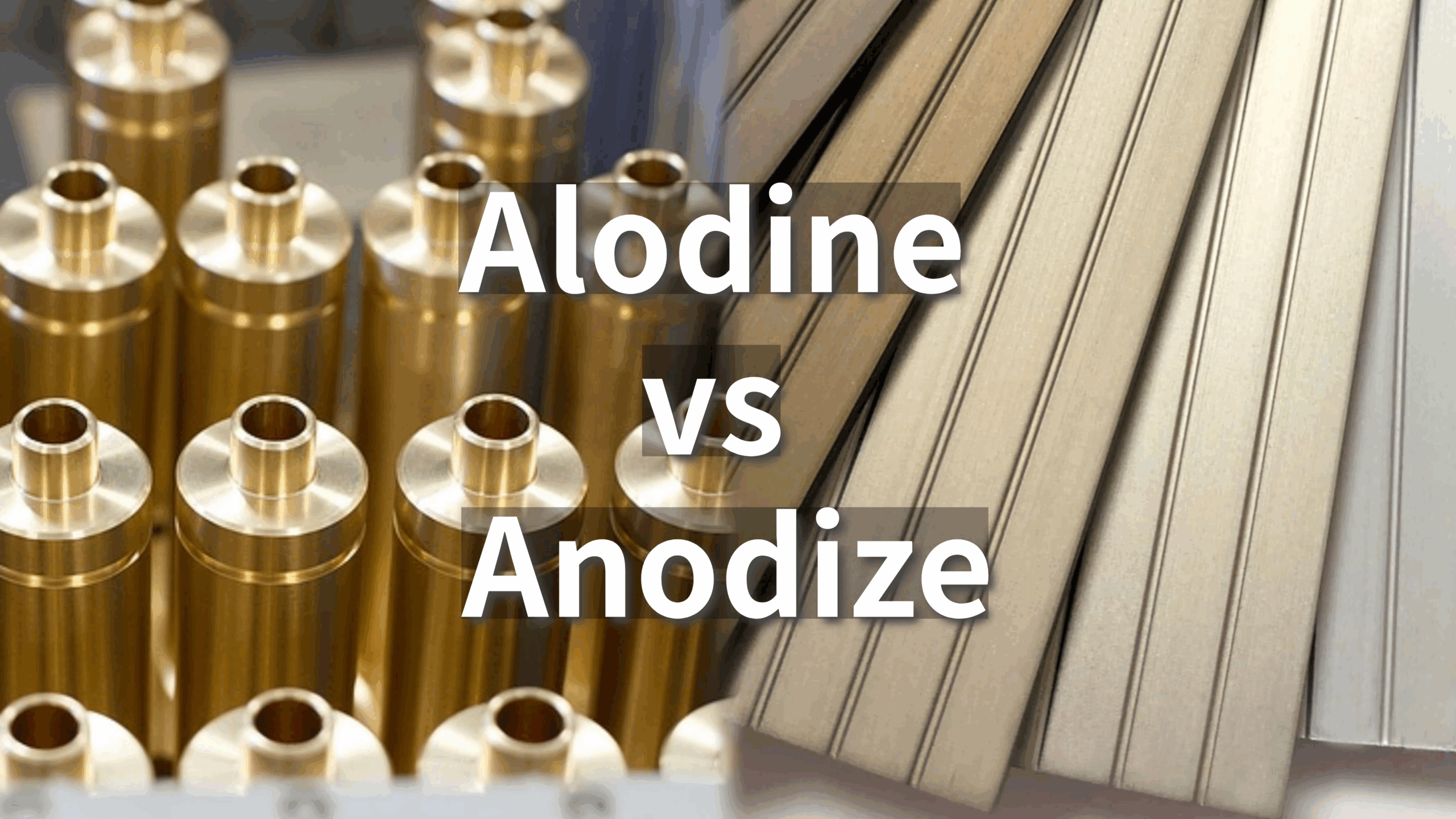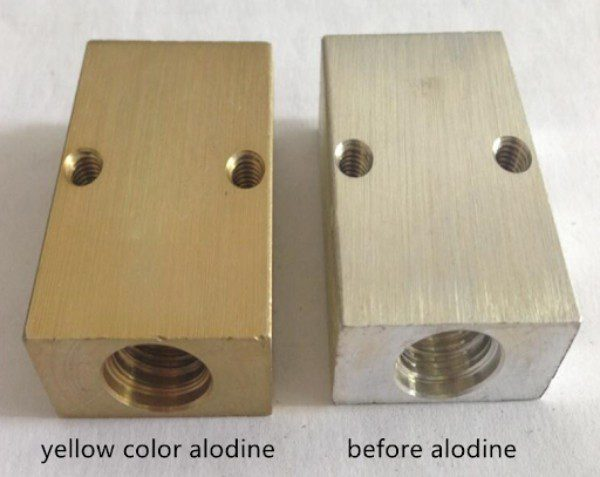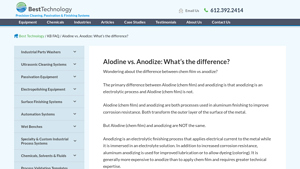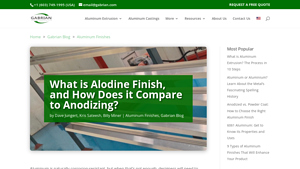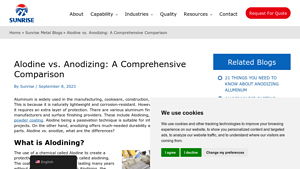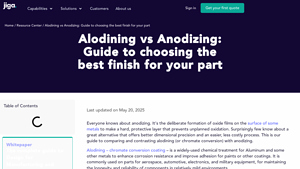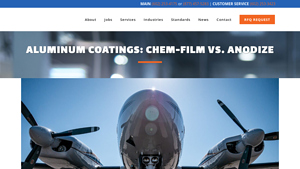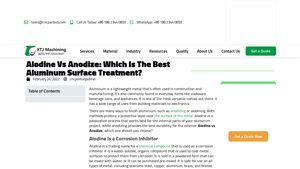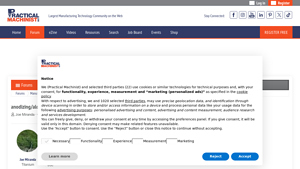Anodizing Vs Alodining Guide: Type, Cost, Top List…
Introduction: Navigating the Global Market for anodizing vs alodining
In the rapidly evolving landscape of aluminum finishing, understanding the differences between anodizing and alodining is crucial for B2B buyers seeking to enhance their manufacturing processes. Sourcing the right surface treatment can significantly impact the durability, aesthetics, and functionality of aluminum components, particularly in industries ranging from aerospace to automotive. This guide delves into the intricacies of anodizing and alodining, exploring their distinct processes, applications, and suitability for various projects.
As international buyers from regions such as Africa, South America, the Middle East, and Europe navigate this global market, they face the challenge of selecting the most effective and cost-efficient finishing solutions. This comprehensive resource covers the essential aspects of each process, including the types of coatings available, their specific applications, and key considerations for supplier vetting. Additionally, we will address cost implications and the technical expertise required for each method, empowering decision-makers to make informed choices that align with their operational needs.
By providing actionable insights and expert analysis, this guide serves as a valuable tool for B2B buyers aiming to optimize their aluminum finishing processes. With the right information at hand, businesses can ensure they select the most appropriate finishing technique—whether it be anodizing for enhanced durability or alodining for electrical conductivity—ultimately driving better product performance and customer satisfaction.
Understanding anodizing vs alodining Types and Variations
| Type Name | Key Distinguishing Features | Primary B2B Applications | Brief Pros & Cons for Buyers |
|---|---|---|---|
| Type I Anodizing | Thin, non-dyed layer; typically used for corrosion resistance. | Aerospace, automotive components | Pros: Lightweight, corrosion-resistant. Cons: Limited color options, less durable than thicker types. |
| Type II Anodizing | Thicker layer; available in various colors; improved durability. | Consumer electronics, architectural applications | Pros: Enhanced aesthetics, good wear resistance. Cons: Higher cost, requires skilled labor. |
| Type III Anodizing | Hard anodizing; very thick layer; excellent wear resistance. | Military, industrial machinery | Pros: Extremely durable, great for harsh environments. Cons: Most expensive option, complex process. |
| Alodine (Chem Film) | Non-electrolytic process; retains electrical conductivity. | Aerospace, electrical components | Pros: Lower cost, minimal skill required. Cons: Less durable, can be easily removed. |
| Alodine Gold | A specific variant of Alodine; provides a gold appearance. | Decorative applications, electronics | Pros: Attractive finish, good corrosion resistance. Cons: Limited to aesthetic applications, less protective than anodizing. |
What Are the Key Characteristics of Type I Anodizing?
Type I anodizing is characterized by its thin, non-dyed layer primarily aimed at enhancing corrosion resistance. This process is often utilized in industries such as aerospace and automotive, where lightweight materials are crucial. B2B buyers should consider the limited aesthetic options, as this type is primarily functional. However, its low cost and effective corrosion protection make it a viable option for parts that require less visual appeal.
How Does Type II Anodizing Stand Out in the Market?
Type II anodizing offers a thicker layer compared to Type I, allowing for various color options and improved durability. This method is suitable for consumer electronics and architectural applications, where aesthetics and durability are essential. While it does come with a higher cost and requires skilled labor, its enhanced wear resistance and visual appeal can justify the investment for buyers looking for both functionality and design.
Why Choose Type III Anodizing for Industrial Applications?
Type III anodizing, or hard anodizing, is distinguished by its significantly thick coating that provides exceptional wear resistance. It is commonly used in military and industrial machinery applications, where components are subjected to harsh conditions. Although it is the most expensive anodizing option and involves a complex process, the extreme durability it offers can lead to lower long-term maintenance costs, making it a worthwhile investment for buyers in demanding industries.
What Are the Benefits of Alodine (Chem Film)?
Alodine, also known as chem film, is a non-electrolytic process that creates a protective chemical film on aluminum while retaining its electrical conductivity. It is favored in aerospace and electrical component applications due to its lower cost and ease of application. However, buyers should be aware that while Alodine provides good corrosion resistance, it is less durable than anodizing and can be easily removed, which may limit its use in high-stress applications.
How Does Alodine Gold Fit into Decorative Applications?
Alodine Gold is a specific variant of the Alodine process that provides an attractive gold appearance to aluminum surfaces. It is primarily used in decorative applications and electronics where aesthetics are important. While it offers good corrosion resistance, its protective capabilities are not as strong as anodizing, making it less suitable for high-performance applications. Buyers should weigh the aesthetic benefits against the potential need for additional protective coatings in demanding environments.
Key Industrial Applications of anodizing vs alodining
| Industry/Sector | Specific Application of anodizing vs alodining | Value/Benefit for the Business | Key Sourcing Considerations for this Application |
|---|---|---|---|
| Aerospace | Anodizing for aircraft components | Enhanced corrosion resistance and durability for safety-critical parts | Compliance with aerospace standards and certifications |
| Automotive | Alodining for electrical connectors and internal parts | Cost-effective protection while retaining electrical conductivity | Supplier capability in providing consistent quality and delivery |
| Medical Devices | Anodizing for surgical instruments and implants | Biocompatibility and increased wear resistance | Need for certified processes and materials for regulatory compliance |
| Construction | Alodining for architectural aluminum facades | Cost-effective solution for aesthetic finishes and corrosion resistance | Local regulations and environmental considerations |
| Military & Defense | Anodizing for armor plating and weapon components | Superior durability and resistance to harsh environments | Proven track record in defense applications and strict quality control |
How is Anodizing Used in Aerospace Applications?
In the aerospace industry, anodizing is essential for enhancing the performance and longevity of aircraft components. This electrolytic process creates a thick aluminum oxide layer, which provides superior corrosion resistance and durability, crucial for safety-critical parts exposed to extreme conditions. International buyers, particularly from regions like Europe and the Middle East, must ensure that suppliers comply with stringent aerospace standards and certifications, which can vary significantly between countries.
What Role Does Alodining Play in the Automotive Sector?
Alodining is widely utilized in the automotive sector, particularly for electrical connectors and internal components. This chemical film process provides a cost-effective protective layer while maintaining the aluminum’s electrical conductivity, essential for modern vehicles. Buyers in South America and Africa should focus on suppliers that can deliver consistent quality and adhere to regional automotive standards, ensuring reliability and performance in automotive applications.
Why is Anodizing Crucial for Medical Devices?
In the medical device sector, anodizing is employed for surgical instruments and implants due to its ability to create a biocompatible surface that resists wear and corrosion. This is particularly important for devices that must withstand repeated sterilization processes. International buyers, especially from Africa and the Middle East, need to prioritize suppliers that adhere to strict regulatory compliance and quality assurance processes to meet health and safety standards.
How is Alodining Applied in Construction Projects?
Alodining finds its application in construction, particularly for aluminum facades and structural elements. This process offers a cost-effective solution that enhances aesthetic finishes while providing corrosion resistance. Buyers from Europe and South America should consider local regulations and environmental factors when sourcing alodining services, as these can impact both the selection of materials and the overall sustainability of construction projects.
What are the Benefits of Anodizing in Military Applications?
In military and defense applications, anodizing is critical for armor plating and weapon components, where durability and resistance to harsh environments are paramount. The anodized layer provides enhanced protection against corrosion and wear, ensuring the longevity of essential equipment. Buyers must seek suppliers with a proven track record in defense applications, as the quality control measures and certifications required are significantly more stringent than in other sectors.
3 Common User Pain Points for ‘anodizing vs alodining’ & Their Solutions
Scenario 1: Cost-Effectiveness Dilemma in Aluminum Finishing
The Problem: B2B buyers often grapple with the decision of whether to invest in anodizing or alodining based on cost constraints. Anodizing, while providing superior durability and corrosion resistance, typically comes with a higher price tag and requires skilled labor, making it less appealing for budget-conscious projects. On the other hand, alodining offers a more economical solution but may not provide the same level of protection, leading to potential long-term costs if parts fail prematurely.
The Solution: To navigate this cost-effectiveness dilemma, buyers should conduct a thorough cost-benefit analysis that includes not only the initial application costs but also the expected lifespan and performance requirements of the parts. Engaging with a reputable supplier who can provide detailed insights into the long-term advantages of each method is crucial. For example, if the parts will be used in a high-corrosion environment, investing in anodizing may save money in the long run by reducing maintenance and replacement costs. Additionally, consider requesting samples or trial runs from suppliers to evaluate performance and durability in real-world conditions, ensuring that the selected method aligns with both budget and performance expectations.
Scenario 2: Technical Expertise and Process Understanding
The Problem: Many B2B buyers, especially those new to aluminum finishing, often lack the technical expertise needed to understand the differences between anodizing and alodining. This gap in knowledge can lead to improper specifications or miscommunication with suppliers, resulting in unsuitable finishes for their applications. As a result, they might face issues such as inadequate corrosion protection, poor aesthetic quality, or failure to meet regulatory standards.
The Solution: To bridge this knowledge gap, buyers should invest in educational resources and training for their teams. This could involve attending workshops, webinars, or industry conferences focused on aluminum finishing technologies. Collaborating closely with experienced suppliers who can provide comprehensive guidance on the properties and applications of anodizing and alodining is also essential. For instance, buyers should ask their suppliers for detailed technical datasheets and case studies that illustrate the performance of each finish in various applications. This proactive approach not only enhances understanding but also empowers buyers to make informed decisions that align with their specific operational needs.
Scenario 3: Environmental and Compliance Concerns
The Problem: With increasing scrutiny on environmental regulations, B2B buyers are often concerned about the environmental impact of their finishing processes. Anodizing and alodining both involve chemicals that can pose environmental risks if not handled properly. Buyers may struggle to ensure compliance with local and international regulations while also meeting their operational requirements.
The Solution: To address these environmental and compliance concerns, buyers should prioritize sourcing from suppliers who adhere to strict environmental standards and offer eco-friendly alternatives. Conducting a life cycle assessment (LCA) of the anodizing and alodining processes can help identify potential environmental impacts and guide decision-making. Additionally, buyers should inquire about the disposal and treatment of spent chemicals, ensuring that their chosen process minimizes waste and complies with regulations. Implementing a robust compliance management system, including regular audits and employee training on environmental practices, will further reinforce their commitment to sustainability and regulatory adherence. This proactive stance not only mitigates risk but can also enhance the company’s reputation in the market.
Strategic Material Selection Guide for anodizing vs alodining
What Are the Key Properties of Aluminum in Anodizing vs Alodining?
Aluminum is the primary material for both anodizing and alodining processes. Its inherent properties, such as lightweight and corrosion resistance, make it a popular choice across various industries. However, the effectiveness of anodizing and alodining can vary based on the specific aluminum alloy used. Common alloys include 6061, 6063, and 7075, each offering different performance characteristics.
-
6061 Aluminum: Known for its good mechanical properties and weldability, 6061 is often used in structural applications. Anodizing enhances its corrosion resistance, making it suitable for outdoor use. However, it may not perform well under high temperatures.
-
6063 Aluminum: This alloy is favored for architectural applications due to its excellent extrudability and surface finish. Anodizing provides a durable layer that can be dyed for aesthetic purposes. Alodining, however, may be preferred for internal components where electrical conductivity is needed.
-
7075 Aluminum: Renowned for its high strength-to-weight ratio, 7075 is typically used in aerospace applications. While anodizing improves its corrosion resistance, the process can be more costly and complex due to the alloy’s sensitivity to the anodizing environment.
What Are the Pros and Cons of Anodizing and Alodining?
Anodizing is a more complex electrolytic process that results in a thicker, more durable oxide layer. This makes anodized aluminum suitable for harsh environments but at a higher cost and with increased manufacturing complexity. The process requires skilled labor and specific equipment, which can be a barrier for manufacturers in developing regions.
Alodining, on the other hand, is a simpler chemical process that creates a thin protective film. It is less expensive and easier to implement, making it attractive for manufacturers looking to minimize costs. However, the coating is less durable than anodizing and may not provide the same level of protection against wear and tear.
How Do Anodizing and Alodining Impact Application Performance?
The choice between anodizing and alodining significantly impacts the performance of aluminum components in various applications. For example, anodized aluminum is preferred in environments exposed to moisture or chemicals, such as in automotive or aerospace applications. The thicker oxide layer provides superior corrosion resistance. In contrast, alodining is often used for internal components where electrical grounding is necessary, as it retains the aluminum’s electrical conductivity.
What Should International B2B Buyers Consider When Selecting Anodizing vs Alodining?
International buyers, especially from regions like Africa, South America, the Middle East, and Europe, should consider local compliance standards and regulations. Common standards such as ASTM, DIN, and JIS may dictate the finishing processes acceptable for specific applications. Additionally, buyers should assess the availability of skilled labor and equipment for anodizing versus alodining in their region, as this can affect the overall cost and feasibility of the finishing process.
Moreover, understanding the local market preferences for durability versus cost will guide buyers in making informed decisions. For instance, while anodizing may be preferred for high-end applications in Europe, alodining might be more suitable for cost-sensitive projects in emerging markets.
Summary Table
| Material | Typical Use Case for anodizing vs alodining | Key Advantage | Key Disadvantage/Limitation | Relative Cost (Low/Med/High) |
|---|---|---|---|---|
| 6061 Aluminum | Structural components, outdoor applications | Good mechanical properties and weldability | Limited performance under high temperatures | Medium |
| 6063 Aluminum | Architectural applications | Excellent surface finish and aesthetic options | Less durable than anodized options | Low |
| 7075 Aluminum | Aerospace components | High strength-to-weight ratio | Higher cost and complexity in anodizing process | High |
| Alodined Aluminum | Internal components requiring conductivity | Lower cost and ease of application | Less durable and can have micro-defects | Low |
This analysis provides a comprehensive overview of the strategic material selection for anodizing versus alodining, equipping B2B buyers with the insights necessary for informed decision-making in their respective markets.
In-depth Look: Manufacturing Processes and Quality Assurance for anodizing vs alodining
What Are the Key Stages in the Anodizing and Alodining Manufacturing Processes?
Understanding the manufacturing processes of anodizing and alodining is essential for B2B buyers looking to make informed decisions about aluminum finishing. Both processes aim to enhance the corrosion resistance of aluminum, but they employ different techniques and have distinct stages.
What Are the Main Stages of Anodizing?
-
Material Preparation: The aluminum parts undergo thorough cleaning to remove any contaminants, oils, or oxidation layers. This step is crucial for ensuring the adhesion of the anodic layer.
-
Electrolytic Process: The cleaned aluminum is submerged in an electrolyte solution (commonly sulfuric acid) and connected as the anode in an electrolytic cell. An electric current is applied, which facilitates the oxidation of the aluminum surface, forming a thick aluminum oxide layer.
-
Post-Treatment: After anodizing, the parts may undergo various post-treatment processes, such as sealing to enhance corrosion resistance and dyeing for aesthetic purposes. Sealing can involve hot water, steam, or chemical treatments.
-
Quality Control: Throughout the anodizing process, quality checkpoints are implemented to ensure that the anodic layer meets specified thickness and quality standards.
What Are the Main Stages of Alodining?
-
Material Preparation: Similar to anodizing, aluminum parts are cleaned to eliminate any surface contaminants. This step is vital for achieving a uniform chemical film.
-
Chemical Treatment: The aluminum parts are immersed in a solution containing chromate compounds, typically at room temperature. The chemical reaction forms a protective film (Alodine) on the aluminum surface without requiring electrical current.
-
Rinsing and Drying: After immersion, the parts are rinsed to remove any residual chemicals and then dried. Unlike anodizing, no sealing is typically required after Alodining, although additional protective coatings can be applied.
-
Quality Control: Alodining processes also include quality checkpoints to verify that the chemical film has been applied uniformly and meets the required specifications.
How Do Quality Assurance Practices Differ Between Anodizing and Alodining?
Quality assurance (QA) is critical in both anodizing and alodining processes, particularly for B2B buyers who require reliable and consistent product quality.
What International and Industry-Specific Standards Are Relevant?
Both anodizing and alodining processes must adhere to international standards such as ISO 9001, which outlines quality management principles. Additionally, industry-specific standards such as MIL-A-8625 (for anodizing) and MIL-DTL-5541 (for Alodining) may apply, depending on the application and industry.
What Are the Key Quality Control Checkpoints?
-
Incoming Quality Control (IQC): This involves inspecting raw materials and components before they enter the production process. For anodizing, this may include checking the aluminum alloy specifications, while for Alodining, the chemical composition of the treatment solution is assessed.
-
In-Process Quality Control (IPQC): During production, operators conduct regular inspections to ensure adherence to process parameters. For anodizing, this could involve monitoring the voltage and current during the electrolytic process. For Alodining, the pH and concentration of the chemical solution are critical factors to monitor.
-
Final Quality Control (FQC): After finishing, both processes undergo a final inspection to verify that the products meet the required specifications. This includes checking the thickness of the anodized layer or the uniformity of the Alodine coating.
What Common Testing Methods Are Used in Anodizing and Alodining?
Testing methods for both anodizing and Alodining are essential for verifying the quality and performance of the finished products.
-
Thickness Measurement: For anodizing, the thickness of the anodic layer is typically measured using tools like micrometers or eddy current thickness gauges. For Alodining, the thickness of the chemical film is less critical but may still be checked for uniformity.
-
Corrosion Resistance Testing: Salt spray tests (ASTM B117) are commonly employed to assess the corrosion resistance of both anodized and Alodined surfaces. This test simulates harsh environmental conditions to evaluate how well the coatings protect the underlying aluminum.
-
Adhesion Testing: For anodized finishes, adhesion is critical, especially if additional coatings (like paint) will be applied. Testing methods like tape tests (ASTM D3359) can determine the adhesion quality.
How Can B2B Buyers Verify Supplier Quality Control?
B2B buyers should take proactive steps to verify the quality control processes of potential suppliers.
-
Supplier Audits: Conducting on-site audits allows buyers to evaluate the supplier’s quality management systems, production processes, and compliance with relevant standards. This step provides insight into the supplier’s commitment to quality.
-
Quality Reports: Requesting quality assurance documentation, including inspection reports, test results, and compliance certificates, helps buyers assess the consistency and reliability of the supplier’s products.
-
Third-Party Inspections: Engaging independent third-party inspectors can provide an unbiased evaluation of the supplier’s quality practices. This is especially important for international transactions where buyers may not have the capacity to conduct their own audits.
What Are the Quality Control Nuances for International B2B Buyers?
For international B2B buyers, especially those from Africa, South America, the Middle East, and Europe, there are specific quality control nuances to consider:
-
Regulatory Compliance: Understanding local regulations and compliance requirements is vital. Buyers should ensure that the anodizing and Alodining processes meet not only international standards but also regional regulations.
-
Cultural and Language Barriers: Engaging suppliers from different regions may present communication challenges. Buyers should ensure that all quality documentation is available in a language they can understand and that there are no ambiguities in quality expectations.
-
Logistics and Supply Chain Management: International shipping can introduce variability in product quality. Buyers should consider how transportation and handling may impact the quality of anodized or Alodined parts and establish protocols to mitigate these risks.
In conclusion, understanding the manufacturing processes and quality assurance practices for anodizing and Alodining can significantly benefit B2B buyers. By focusing on the key stages, quality control checkpoints, testing methods, and verification strategies, buyers can make informed choices that align with their specific needs and industry standards.
Practical Sourcing Guide: A Step-by-Step Checklist for ‘anodizing vs alodining’
Introduction
Navigating the decision between anodizing and alodining for aluminum finishing can be complex. This guide provides a practical sourcing checklist tailored for B2B buyers, focusing on key steps to ensure you select the right finishing process for your specific needs. By following this checklist, you can make informed decisions, optimize costs, and ensure quality in your aluminum components.
Step 1: Define Your Technical Specifications
Before engaging suppliers, it is essential to outline your technical requirements. Determine the intended application of the finished aluminum parts, such as exposure to corrosive environments or the need for electrical conductivity. This clarity will help you communicate effectively with potential suppliers and assess their capabilities.
- Considerations:
- Specify the environmental conditions the parts will face.
- Identify if aesthetic qualities, like color or surface finish, are important.
Step 2: Understand the Differences Between Anodizing and Alodining
Familiarize yourself with the fundamental differences between anodizing and alodining. Anodizing is an electrolytic process that enhances durability and corrosion resistance, while alodining provides a chemical film that retains electrical conductivity. Knowing these distinctions will guide your selection based on your application needs.
- Key Points:
- Anodizing is typically more expensive but offers superior durability.
- Alodining is cost-effective and simpler, ideal for internal components.
Step 3: Evaluate Potential Suppliers
Before committing, thoroughly vet potential suppliers. Request detailed information about their processes, certifications, and industry experience. This step is crucial to ensure that the supplier can meet your specific requirements and adhere to quality standards.
- What to Look For:
- Company profiles that highlight experience in anodizing or alodining.
- Customer testimonials or case studies demonstrating successful projects.
Step 4: Request Sample Finishes
Once you have shortlisted suppliers, request samples of their anodized and alodined finishes. This hands-on evaluation allows you to assess the quality and performance of their coatings firsthand. Pay attention to factors such as finish uniformity, thickness, and resistance to corrosion.
- Evaluation Criteria:
- Inspect the samples for visual defects and uniformity.
- Conduct tests to evaluate corrosion resistance and conductivity if applicable.
Step 5: Verify Compliance with Industry Standards
Ensure that your chosen supplier complies with relevant industry standards and regulations. This is particularly important in sectors like aerospace, automotive, and medical, where safety and quality are paramount. Compliance not only ensures product quality but also mitigates risks in supply chain management.
- Important Standards:
- Check for certifications such as ISO 9001 or specific aerospace standards like MIL-A-8625 for anodizing.
Step 6: Discuss Lead Times and Costs
Engage in discussions with suppliers regarding lead times and pricing structures. Understanding these factors upfront will help you plan your production schedules and budget effectively. Be wary of suppliers who cannot provide clear timelines or transparent pricing.
- Negotiation Tips:
- Inquire about bulk order discounts or long-term partnership agreements.
- Ensure that all costs, including shipping and handling, are clearly outlined.
Step 7: Establish a Quality Assurance Process
Finally, establish a quality assurance (QA) process to monitor the performance of the finished products. Define criteria for inspection and testing to ensure that the anodized or alodined finishes meet your specifications consistently. A robust QA process is vital for maintaining product integrity and customer satisfaction.
- QA Considerations:
- Schedule regular inspections during production.
- Implement feedback loops with suppliers for continuous improvement.
By following this step-by-step checklist, B2B buyers can confidently navigate the selection process for anodizing and alodining, ensuring they make informed decisions that align with their operational needs and quality standards.
Comprehensive Cost and Pricing Analysis for anodizing vs alodining Sourcing
What Are the Key Cost Components for Anodizing and Alodining?
When comparing anodizing and alodining, it’s essential to understand the distinct cost structures associated with each process.
Material Costs
The materials required for anodizing typically include aluminum, sulfuric acid (or other electrolytes), and various dyes if coloring is desired. In contrast, alodining primarily requires the chemical solution used for the conversion coating. Generally, anodizing materials may incur higher costs due to the complexity of the process and the chemicals involved.
Labor Costs
Labor costs for anodizing tend to be higher, as the process requires skilled technicians to manage the electrolytic process, ensure safety, and maintain quality. Alodining, being less technical, may demand lower labor costs due to its simpler application process, which can often be performed by less specialized personnel.
Manufacturing Overhead
Overhead costs can differ significantly between the two processes. Anodizing facilities may require more expensive equipment and higher maintenance costs due to the need for electrochemical setups. Alodining facilities, on the other hand, may have lower overhead since the equipment is generally less complex and easier to maintain.
Tooling and Quality Control (QC)
Tooling costs are often comparable, but anodizing may require more specialized tooling to accommodate various aluminum alloys and thicknesses. In terms of QC, both processes need rigorous testing, but anodized parts may require additional tests for durability and corrosion resistance, impacting overall costs.
Logistics and Margins
Logistics costs can fluctuate based on the location of suppliers and the need for specialized handling of chemicals, especially for anodizing. Margins may also vary; suppliers of anodized products often charge a premium due to the enhanced properties and applications of anodized aluminum.
What Influences Pricing in Anodizing vs Alodining?
How Do Volume and Specifications Affect Prices?
Volume plays a crucial role in pricing. High-volume orders often benefit from economies of scale, reducing per-unit costs significantly. Custom specifications can also impact pricing; anodized products may incur higher costs for custom colors or finishes compared to standard alodining applications.
What Role Do Quality and Certifications Play?
Quality expectations and certifications can influence pricing. Anodized aluminum is typically associated with stringent quality requirements, particularly in industries like aerospace and automotive. Suppliers may charge more for certified anodized parts due to the additional testing and documentation involved.
How Do Supplier Factors Impact Costs?
Supplier reputation and expertise can also affect prices. Established suppliers may charge higher rates due to their reliability and quality assurance, while newer suppliers might offer competitive pricing to gain market traction.
What Are the Implications of Incoterms on Sourcing Costs?
Understanding Incoterms is essential for international buyers. Terms such as FOB (Free On Board) or CIF (Cost, Insurance, and Freight) can significantly impact total costs. Buyers should clarify these terms with suppliers to avoid unexpected expenses.
What Tips Can Help Buyers Negotiate Better Prices?
How to Leverage Negotiation Tactics?
When negotiating, consider bundling orders or establishing long-term relationships with suppliers to secure better pricing. Highlighting your position as a repeat customer can also encourage suppliers to offer discounts.
What Should You Consider for Cost-Efficiency?
Total Cost of Ownership (TCO) is crucial for evaluating the overall investment. While anodizing may have higher upfront costs, its longevity and durability could lead to lower maintenance and replacement costs over time.
What Pricing Nuances Should International Buyers Be Aware Of?
International buyers should be aware of currency fluctuations, tariffs, and import duties that may affect final costs. Additionally, cultural differences in negotiation styles may impact discussions, especially in regions like Africa and South America, where personal relationships play a significant role in business dealings.
Disclaimer
Prices for anodizing and alodining can vary widely based on market conditions, supplier capabilities, and specific project requirements. Always consult with multiple suppliers to obtain indicative prices tailored to your needs.
Alternatives Analysis: Comparing anodizing vs alodining With Other Solutions
Exploring Alternatives to Anodizing and Alodining
In the realm of metal finishing, particularly for aluminum, anodizing and alodining are two of the most widely used processes for enhancing corrosion resistance and overall durability. However, there are several alternative methods available that can also meet specific requirements based on factors such as cost, application, and desired performance. This section will explore how anodizing and alodining compare with other viable solutions.
Comparison Table
| Comparison Aspect | Anodizing Vs Alodining | Powder Coating | Electroless Nickel Plating |
|---|---|---|---|
| Performance | High corrosion resistance; non-conductive | Excellent durability; decorative options | Strong wear resistance; high corrosion resistance |
| Cost | Higher due to complexity and labor | Moderate; varies with finish | Moderate to high; depends on thickness |
| Ease of Implementation | Requires skilled labor; complex process | Simple application; less skill required | Moderate skill; requires precise control |
| Maintenance | Low; durable finish | Moderate; can chip or fade | Low; resistant to wear |
| Best Use Case | Aerospace, automotive, and architectural | Consumer goods, automotive parts | Aerospace, military, and electronics |
Detailed Breakdown of Alternatives
What are the Advantages and Disadvantages of Powder Coating?
Powder coating is a popular finishing technique that involves applying a dry powder to a surface and then curing it under heat. The result is a hard, durable finish that can be both functional and aesthetically pleasing.
Pros: Powder coating provides excellent durability and is available in a wide range of colors. It is also more environmentally friendly compared to traditional liquid coatings, as it emits fewer volatile organic compounds (VOCs).
Cons: While powder coating is less expensive than anodizing, it can chip or fade over time, particularly in harsh environments. Its non-conductive nature may not be suitable for applications requiring electrical grounding.
How Does Electroless Nickel Plating Compare?
Electroless nickel plating is a chemical process that deposits a layer of nickel onto a substrate without the use of electrical current. This method creates a uniform coating that adheres well to complex geometries.
Pros: Electroless nickel plating offers excellent corrosion resistance and wear resistance, making it ideal for applications in harsh environments, such as aerospace and military. The coating can also be applied uniformly, even on intricate shapes.
Cons: The process can be more expensive than both anodizing and alodining, particularly for thicker coatings. It also requires careful control of the chemical environment to ensure consistent results, necessitating skilled labor.
Conclusion: How Can B2B Buyers Choose the Right Solution?
Selecting the appropriate surface finishing method depends on various factors, including the specific application, environmental conditions, budget, and desired performance characteristics. B2B buyers should carefully evaluate their needs, considering aspects such as corrosion resistance, electrical conductivity, and aesthetic requirements. By understanding the strengths and limitations of anodizing, alodining, and their alternatives like powder coating and electroless nickel plating, buyers can make informed decisions that align with their operational goals and product specifications.
Essential Technical Properties and Trade Terminology for anodizing vs alodining
What Are the Key Technical Properties of Anodizing and Alodining?
Understanding the essential technical properties of anodizing and alodining is crucial for international B2B buyers, especially when making decisions about aluminum finishing processes. Here are some key specifications:
-
Corrosion Resistance: This property measures the ability of the aluminum surface to withstand deterioration from environmental factors such as moisture and chemicals. Anodizing creates a thicker aluminum oxide layer that provides superior corrosion resistance compared to alodining. This specification is vital for applications in harsh environments, such as aerospace and automotive industries, where durability is paramount.
-
Electrical Conductivity: While anodizing typically reduces electrical conductivity due to the insulating nature of the oxide layer, alodining preserves it, making it suitable for applications requiring electrical grounding. Buyers in industries like telecommunications and electronics must consider this property to ensure compatibility with their components.
-
Thickness of Coating: The thickness of the anodized or alodined layer can significantly affect performance. Anodizing usually results in a thicker layer, which enhances durability and wear resistance. Understanding the required thickness for specific applications helps in selecting the appropriate finishing process, as it impacts both cost and longevity.
-
Surface Finish: The visual and tactile characteristics of the aluminum surface, such as smoothness and color, can vary between anodizing and alodining. Anodizing offers a wide range of aesthetic options, including coloring, making it suitable for consumer-facing products. In contrast, alodining provides a more utilitarian finish that is often sufficient for internal components.
-
Environmental Impact: Buyers should consider the environmental implications of each process. Anodizing is generally viewed as more eco-friendly, while alodining can involve hazardous chemicals that require careful disposal. This consideration is especially important for companies committed to sustainability practices.
What Are Common Trade Terms Related to Anodizing and Alodining?
Navigating the terminologies associated with anodizing and alodining is essential for effective communication and procurement. Here are some commonly used terms:
-
OEM (Original Equipment Manufacturer): Refers to companies that produce parts or components that are used in another company’s end products. Understanding OEM relationships can help buyers ensure that the anodized or alodined components meet their specific quality and performance standards.
-
MOQ (Minimum Order Quantity): This term indicates the smallest quantity of a product that a supplier is willing to sell. Knowing the MOQ for anodizing and alodining services helps buyers plan their purchasing strategy and manage inventory costs effectively.
-
RFQ (Request for Quotation): A document issued by a buyer to solicit price quotes from suppliers for specific goods or services. An RFQ for anodizing or alodining will typically include details such as material specifications, dimensions, and required finish, enabling suppliers to provide accurate pricing.
-
Incoterms (International Commercial Terms): These are internationally recognized rules that define the responsibilities of buyers and sellers regarding the delivery of goods. Understanding Incoterms is crucial for international transactions involving anodized or alodined products, as they clarify shipping, insurance, and risk management responsibilities.
-
Lead Time: This term refers to the time it takes from placing an order until the product is delivered. Lead times can vary significantly between anodizing and alodining processes, depending on factors such as complexity and coating thickness. Buyers should consider lead times when planning their production schedules.
By familiarizing themselves with these technical properties and trade terms, B2B buyers can make informed decisions that align with their operational requirements and market demands.
Navigating Market Dynamics and Sourcing Trends in the anodizing vs alodining Sector
What are the Current Market Trends Influencing Anodizing and Alodining?
The anodizing and alodining sectors are witnessing significant transformations driven by global market dynamics and technological advancements. As industries increasingly prioritize lightweight materials, aluminum finishing processes such as anodizing and alodining are gaining traction, particularly in aerospace, automotive, and construction sectors. The demand for anodized aluminum is propelled by its superior durability and aesthetic appeal, making it favorable for exterior applications. Conversely, alodining is favored for internal components due to its cost-effectiveness and ability to maintain electrical conductivity, which is essential for certain electronic applications.
Emerging trends indicate a growing inclination towards automation and digitalization in manufacturing processes. B2B buyers are increasingly seeking suppliers who leverage advanced technologies for precision and efficiency. Furthermore, the shift towards local sourcing is notable, particularly in regions like Africa and South America, where businesses are looking to reduce lead times and transportation costs. This trend is amplified by the need for reliable partnerships that understand local regulations and market nuances, particularly in countries like Nigeria and Vietnam.
How Do Sustainability and Ethical Sourcing Impact Anodizing and Alodining?
Sustainability is becoming a critical factor for international B2B buyers in the anodizing and alodining sectors. The environmental impact of these processes, particularly in terms of waste management and chemical usage, is under scrutiny. Anodizing requires significant energy input and generates waste that must be carefully managed, while alodining processes can involve hazardous materials that present disposal challenges.
Ethical sourcing practices are increasingly important, as buyers are more inclined to partner with manufacturers who demonstrate commitment to environmental stewardship and responsible supply chain management. Certifications such as ISO 14001 (Environmental Management) and adherence to RoHS (Restriction of Hazardous Substances) regulations can provide reassurance to buyers regarding the sustainability of their suppliers. Furthermore, the adoption of greener alternatives in chemical formulations for both anodizing and alodining processes is becoming a competitive differentiator, appealing to environmentally conscious companies.
What is the Evolution of Anodizing and Alodining in the B2B Landscape?
The history of anodizing and alodining dates back to the mid-20th century when these processes were first developed to enhance aluminum’s natural properties. Anodizing, initially used primarily in the aerospace sector, has evolved to become a standard finishing technique across various industries, including automotive and consumer electronics. Its ability to provide a durable, corrosion-resistant, and aesthetically pleasing surface has led to widespread adoption.
Alodining emerged as a more cost-effective alternative, particularly for applications requiring conductivity and lower durability. Over the years, advancements in chemical formulations and application techniques have improved the performance and safety of alodining processes. As global industries continue to innovate, both anodizing and alodining will likely adapt to meet the evolving demands of B2B buyers, focusing on quality, sustainability, and efficiency.
Frequently Asked Questions (FAQs) for B2B Buyers of anodizing vs alodining
-
How do I choose between anodizing and alodining for my aluminum parts?
Choosing between anodizing and alodining depends on the specific requirements of your application. Anodizing provides a thicker, more durable coating that enhances corrosion resistance and can be dyed for aesthetic purposes, making it ideal for external components exposed to harsh conditions. Conversely, alodining offers a less expensive and simpler solution, suitable for internal components where electrical conductivity is necessary. Evaluate factors such as cost, required durability, conductivity needs, and aesthetic considerations to make an informed decision. -
What is the most cost-effective option for aluminum finishing?
Alodining is generally the more cost-effective option compared to anodizing. The process of alodining is simpler and requires less technical expertise, resulting in lower labor and equipment costs. If your project involves large quantities of internal aluminum components that need corrosion resistance without the need for dyeing or aesthetic finishes, alodining may be the best choice. However, for applications demanding higher durability and environmental resistance, investing in anodizing could yield better long-term value despite the higher upfront costs. -
What are the environmental considerations when choosing anodizing or alodining?
Both anodizing and alodining have environmental implications. Anodizing involves the use of electrolytic solutions and can generate waste that requires careful disposal, making it essential to choose suppliers compliant with environmental regulations. Alodining, while less complex, also poses disposal challenges due to chemical contents. When sourcing these services, inquire about the supplier’s environmental practices and certifications to ensure they align with your sustainability goals. -
How do I vet suppliers for anodizing and alodining services?
When vetting suppliers, consider their experience, certifications, and customer reviews. Look for suppliers who specialize in aluminum finishing and have a proven track record in your industry. Request samples of previous work to evaluate quality. Additionally, check if they adhere to international quality standards such as ISO certifications. Establishing open communication about your specific needs and asking for references can also help you gauge their reliability and expertise. -
What are the typical minimum order quantities (MOQs) for anodizing and alodining services?
Minimum order quantities can vary significantly between suppliers and depend on the complexity of the finishing process. Generally, anodizing may have higher MOQs due to its more involved process and equipment requirements. Alodining, being simpler, may allow for lower MOQs, making it more accessible for smaller orders. Always confirm MOQs with potential suppliers and assess how these align with your production needs to avoid unnecessary costs. -
What payment terms should I expect when sourcing anodizing or alodining services?
Payment terms can differ by supplier and region, but common practices include upfront deposits, payment upon completion, or net terms ranging from 30 to 90 days. In international transactions, consider the impact of currency fluctuations and payment processing fees. Ensure that the payment terms are clearly defined in your contract to avoid misunderstandings and secure a smooth transaction process. -
How can I ensure quality assurance in anodizing and alodining processes?
To ensure quality assurance, request detailed documentation of the finishing process from your supplier, including material certifications and inspection reports. It’s advisable to establish a set of quality standards and conduct periodic audits or inspections during production. Discuss the supplier’s quality control measures, such as adherence to ISO standards or in-house testing protocols, to confirm their commitment to delivering high-quality finishes. -
What logistics considerations should I keep in mind when importing anodized or alodined parts?
When importing finished aluminum parts, consider shipping methods, delivery times, and customs regulations specific to your region. Ensure that the supplier provides proper documentation for customs clearance, including certificates of compliance and material safety data sheets. Additionally, factor in potential tariffs and shipping costs when budgeting. Partnering with a logistics provider experienced in handling specialized materials can also streamline the process and minimize delays.
Important Disclaimer & Terms of Use
⚠️ Important Disclaimer
The information provided in this guide, including content regarding manufacturers, technical specifications, and market analysis, is for informational and educational purposes only. It does not constitute professional procurement advice, financial advice, or legal advice.
While we have made every effort to ensure the accuracy and timeliness of the information, we are not responsible for any errors, omissions, or outdated information. Market conditions, company details, and technical standards are subject to change.
B2B buyers must conduct their own independent and thorough due diligence before making any purchasing decisions. This includes contacting suppliers directly, verifying certifications, requesting samples, and seeking professional consultation. The risk of relying on any information in this guide is borne solely by the reader.
Top 7 Anodizing Vs Alodining Manufacturers & Suppliers List
1. Best Technology Inc – Aluminum Finishing Solutions
Domain: besttechnologyinc.com
Registered: 2001 (24 years)
Introduction: Alodine (chem film) and anodizing are both processes used in aluminum finishing to improve corrosion resistance. The primary difference is that anodizing is an electrolytic process that applies electrical current to the metal while immersed in an electrolyte solution, whereas Alodine does not use electrical current and is typically performed at room temperature. Anodizing is generally more expensi…
2. Gabrian – Alodine Finish
Domain: gabrian.com
Registered: 2000 (25 years)
Introduction: Alodine finish is a type of conversion coating for aluminum that creates a thin protective film to prevent corrosion and can serve as a primer for painting. It is often referred to as chromate conversion coating or chem film. The Alodine® product is a registered trademark of Henkel, Inc., and similar products include Iridite 14-2®. Alodining is typically performed using a chemical bath process, re…
3. Sunrise Metal – Alodine Passivation
Domain: sunrise-metal.com
Registered: 2015 (10 years)
Introduction: Alodine: A passivation technique suitable for internal parts of aluminum projects. Advantages include lower cost, improved corrosion and scratch protection, good electrical and thermal conductivity, no need for primer, and minimal skill required. Disadvantages include easy removal of coating, micro-defects, environmental concerns, and potential skin irritation. Anodizing: An electrolytic process t…
4. Jiga – Alodining Coating Solutions
Domain: jiga.io
Registered: 2020 (5 years)
Introduction: Alodining (chromate conversion coating) is a chemical treatment primarily for Aluminum, enhancing corrosion resistance and improving paint adhesion. It is used in aerospace, automotive, electronics, and military applications. Alodine creates a thin, electrically conductive coating, ideal for precision parts. Common types include Alodine 1200 and 1000 series, offering excellent corrosion resistance…
5. Chem Research Co – Chem-Film Coatings
Domain: chemresearchco.com
Registered: 1998 (27 years)
Introduction: Chem-Film (Alodine) Coatings:
– Also known as alodine or iridite.
– Chemical conversion coating for aluminum surfaces.
– Protects against corrosion and serves as a base for paint coatings.
– Does not alter dimensions or weight of finished parts.
– Easier and less expensive to apply than anodized coatings.
– Retains thermal and electrical conductivity.
– Common uses: heat sinks, aircraft hul…
6. CNC Parts XTJ – Alodine Corrosion Inhibitor
Domain: cncpartsxtj.com
Registered: 2019 (6 years)
Introduction: Alodine is a corrosion inhibitor used as a passivation process for aluminum and other metals. It is a water-soluble, organic compound that forms a protective barrier against corrosion. Alodine is applied as a chromate conversion coating and does not alter the existing characteristics of the metal. It is suitable for various metals including stainless steel, copper, aluminum, brass, and bronze. The…
7. Practical Machinist – Anodizing and Alodizing Services
Domain: practicalmachinist.com
Registered: 2000 (25 years)
Introduction: 1. Anodizing: An electro-chemical process that increases the natural oxide layer on aluminum parts, providing corrosion resistance. Minimum cost for anodizing parts is around $75, with prices dropping to $0.25 per piece for larger quantities. 2. Alodizing: A proprietary term for applying Alodine, a chemical treatment that creates a thin anti-oxidizing coating, typically light gold to tan in color….
Strategic Sourcing Conclusion and Outlook for anodizing vs alodining
What Are the Key Takeaways for B2B Buyers on Anodizing vs. Alodining?
In summary, both anodizing and Alodining offer distinct advantages tailored to specific industrial needs. Anodizing delivers superior durability and corrosion resistance, making it ideal for applications demanding high performance and aesthetic appeal. Conversely, Alodining stands out for its cost-effectiveness and ease of application, particularly when electrical conductivity is essential. Understanding these differences is crucial for making informed sourcing decisions that align with your operational requirements and budget constraints.
How Does Strategic Sourcing Enhance Your Competitive Edge?
Strategic sourcing is vital in optimizing supply chain efficiency and ensuring product quality. By evaluating the specific needs of your projects—whether based in Africa, South America, the Middle East, or Europe—you can select the most suitable finishing process. This not only enhances product performance but also drives down costs, providing a competitive advantage in an increasingly global marketplace.
What Should You Do Next?
As you navigate your sourcing strategies, consider engaging with suppliers who specialize in both anodizing and Alodining. Leveraging their expertise can guide you in selecting the right process for your applications. Embrace the opportunity to enhance your product offerings by making informed decisions today, ensuring that your business remains at the forefront of innovation and quality in your industry.
